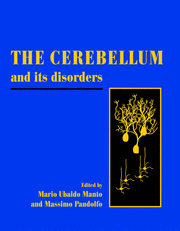Book contents
- Frontmatter
- Contents
- List of contributors
- Preface
- Acknowledgments
- Foreword by Sid Gilman
- PART I INTRODUCTION
- PART II THEORIES OF CEREBELLAR CONTROL
- PART III CLINICAL SIGNS AND PATHOPHYSIOLOGICAL CORRELATIONS
- PART IV SPORADIC DISEASES
- 10 Congenital malformations of the cerebellum and posterior fossa
- 11 Multiple system atrophy and idiopathic late-onset cerebellar ataxia
- 12 Corticobasal degeneration
- 13 Cerebellar stroke
- 14 Immune diseases
- 15 Infectious diseases: radiology and treatment of cerebellar abscesses
- 16 Other infectious diseases
- 17 Cerebellar disorders in cancer
- 18 Posterior fossa trauma
- 19 Thyroid hormone and cerebellar development
- 20 Endocrine disorders: clinical aspects
- PART V TOXIC AGENTS
- PART VI ADVANCES IN GRAFTS
- PART VII NEUROPATHOLOGY
- PART VIII DOMINANTLY INHERITED PROGRESSIVE ATAXIAS
- PART IX RECESSIVE ATAXIAS
- Index
10 - Congenital malformations of the cerebellum and posterior fossa
from PART IV - SPORADIC DISEASES
Published online by Cambridge University Press: 06 July 2010
- Frontmatter
- Contents
- List of contributors
- Preface
- Acknowledgments
- Foreword by Sid Gilman
- PART I INTRODUCTION
- PART II THEORIES OF CEREBELLAR CONTROL
- PART III CLINICAL SIGNS AND PATHOPHYSIOLOGICAL CORRELATIONS
- PART IV SPORADIC DISEASES
- 10 Congenital malformations of the cerebellum and posterior fossa
- 11 Multiple system atrophy and idiopathic late-onset cerebellar ataxia
- 12 Corticobasal degeneration
- 13 Cerebellar stroke
- 14 Immune diseases
- 15 Infectious diseases: radiology and treatment of cerebellar abscesses
- 16 Other infectious diseases
- 17 Cerebellar disorders in cancer
- 18 Posterior fossa trauma
- 19 Thyroid hormone and cerebellar development
- 20 Endocrine disorders: clinical aspects
- PART V TOXIC AGENTS
- PART VI ADVANCES IN GRAFTS
- PART VII NEUROPATHOLOGY
- PART VIII DOMINANTLY INHERITED PROGRESSIVE ATAXIAS
- PART IX RECESSIVE ATAXIAS
- Index
Summary
Introduction
Congenital anomalies of the cerebellum cover a broad range of entities, with the scale of the malformation varying from the microscopic, even molecular, to the macroscopic. It is the latter extreme of anomalies in the gross anatomical structure of the cerebellum for which surgical intervention may be indicated. The major surgical entities are (a) the Chiari malformations, which represent herniation of the lower parts of the midline cerebellum through the foramen magnum, and (b) the Dandy–Walker malformation and its variants, involving failure of formation of part of the midline structures of the cerebellum and compression by a fluid-filled cyst. In both cases, surgical intervention is aimed at decompressing these structures. To an increasing degree, surgical decision-making is determined by precise anatomical diagnosis, revealed by new imaging techniques. This chapter describes both the diagnostic schemes and the surgical interventions available and on the horizon today.
Normal embryology and development
The cerebellum has the longest period of embryological development of any major structure of the brain (Lemire et al., 1975; see also Chapter 2). Neuroblastic proliferation in the cerebellar plates is recognized at 32 days, but neuronal migration from the plates is not complete until one year postnatally. As a result of this extended ontogenesis, the cerebellum is vulnerable to teratogenic insult for longer than most parts of the central nervous system (CNS). During weeks 8–13 (all dates approximate) intense neuroblastic activity causes extraventricular ballooning of the cerebellum, which then starts to subdivide (Kollias et al., 1993).
- Type
- Chapter
- Information
- The Cerebellum and its Disorders , pp. 161 - 177Publisher: Cambridge University PressPrint publication year: 2001

